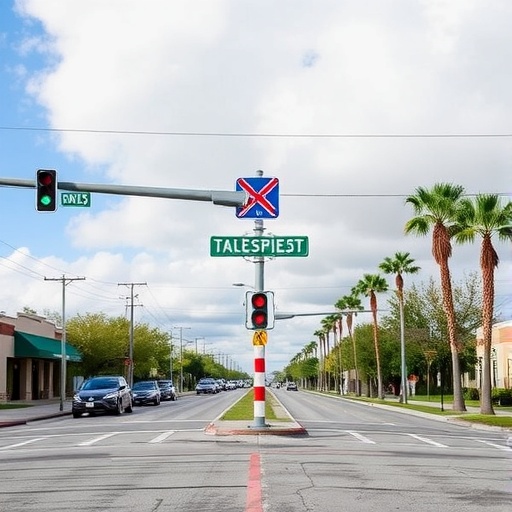In a groundbreaking study published in Nature, Tang et al. unveil a critical safeguard mechanism that ensures the fidelity of genetic recombination during meiosis—a process key to sexual reproduction and genetic diversity. This research illuminates how cells protect the delicate structures known as double Holliday junctions (dHJs), which are pivotal intermediates in chromosomal crossover events. These insights lay a foundation for understanding how meiotic crossover formation is tightly regulated to prevent genomic instability, a factor linked to infertility and hereditary diseases.
Meiotic recombination relies heavily on the formation and proper resolution of dHJs, which form between homologous chromosomes to facilitate the exchange of genetic material. These junctions typically persist through the pachytene stage of meiosis I, a prolonged prophase arrest that allows crossover events to complete. The researchers focused on the role of cohesin proteins, particularly Rec8, and the interplay between various enzymatic complexes involved in dHJ resolution.
The study highlights that dHJs usually remain stable in cells arrested at pachytene due to the lack of active resolution enzymes. Normally, the polo-like kinase Plk1 (also known as Cdc5) triggers dHJ resolution, but its expression is governed by the transcription factor Ndt80. In mutants where Ndt80-dependent expression is blocked, dHJs are preserved, underscoring a regulatory checkpoint that prevents premature resolution.
Strikingly, when the cohesin component Rec8 was degraded using an auxin-inducible degron system (AID), the team observed a marked threefold reduction in dHJ levels, even though the cells were still arrested at pachytene. This suggests that the structural integrity provided by cohesin on meiotic chromosomes plays a protective role, shielding dHJs from unexpected resolution pathways that do not rely on Plk1. The results imply that chromosome architecture actively preserves meiotic recombination intermediates.
A compelling candidate responsible for this aberrant resolution, the researchers posited, is the STR complex, composed of Sgs1, Top3, and Rmi1 in budding yeast—the homolog of the human BLM helicase complex. The STR complex is known for its ability to dissolve dHJs into non-crossover products, a process crucial for maintaining genomic stability. Through simultaneous degradation of both Rec8 and Top3, the researchers demonstrated that dHJ levels were stabilized, confirming the STR complex’s role in the unintended dissolution of these recombination intermediates.
Further supporting this model, the degradation of the cohesin subunit Smc3 along with Top3 similarly stabilized dHJs, solidifying the interplay between chromosome cohesion and dHJ protection. Significantly, the disappearance of dHJs upon Rec8 degradation alone corresponded to an increase in non-crossover products, highlighting a shift from crossover-favoring resolution to a non-crossover pathway mediated by STR complex dissolution activity.
Delving deeper into meiotic outcomes, the team showed that when cells were released from pachytene arrest while degrading both Rec8 and Top3, crossover formation was substantially rescued. Crossovers increased by approximately 2.6-fold compared to the degradation of Rec8 alone, while non-crossovers correspondingly decreased. These results provide strong evidence that avoiding STR-mediated dissolution preserves crossover events, essential for accurate chromosome segregation.
Intriguingly, parallel experiments degrading both Rec8 and Sgs1 also restored crossover levels, reinforcing the STR complex as a critical factor in controlling dHJ resolution pathways. Moreover, similar observations were made when Cart1-dependent (Zip1-AID) or Msh4-AID cohesin-related components were degraded alongside Top3, with joint molecule stability and crossover formation partially restored. This suggests a common mechanistic theme where chromosome axis and central element components guard against STR-mediated interference.
The physical manifestations of these molecular interactions were evaluated through immunostaining of pachytene chromosomes. Although joint molecule stability was rescued during double degradation of cohesin and Top3, cytological structures such as the synaptonemal complex (SC) and crossover recombination complexes (CRCs) were dismantled similarly to when cohesin components alone were degraded. This indicates that while dHJ protection promotes crossover maintenance, it cannot compensate for the structural disassembly of chromosome axes and SCs.
Taken together, these findings define a crucial checkpoint in meiotic prophase where cohesin-based chromosome structure, SC transverse filaments, and CRCs collectively shield crossover-designated dHJs from premature dissolution by the STR helicase complex. Failure of this protection diverts dHJs into non-crossover resolvants, compromising crossover frequency and, consequently, the accurate segregation of homologous chromosomes.
The discovery that meiosis employs both architectural and enzymatic safeguards to ensure crossover formation not only deepens our comprehension of the fundamental processes governing gametogenesis but also provides a potential molecular basis for certain meiotic defects. Aberrant crossover control is a known source of infertility, miscarriages, and congenital disorders, positioning these insights at the forefront of reproductive biology and genomic medicine.
Moreover, this study underscores the delicate balance meiotic cells must achieve between maintaining recombination intermediates long enough to promote crossovers, yet resolving them efficiently before chromosome segregation. The dualistic role of the STR complex—serving as both guardian against excessive crossover formation yet a potential hazard if unregulated—reveals the complexity of meiotic regulation.
Future research directions could explore targeted manipulation of cohesin and STR complex functions to correct meiotic errors or improve fertility treatments. Additionally, the conserved nature of these complexes across eukaryotes opens pathways for comparative studies in human meiosis and the development of therapeutic interventions for disorders stemming from recombination defects.
In all, Tang et al.’s elucidation of how Rec8–cohesin and associated chromosome structures protect dHJs from STR-mediated resolution represents a pivotal advancement in our understanding of meiotic crossover assurance. It encapsulates the sophisticated molecular choreography underlying genetic diversity and genome stability in sexual reproduction—an orchestration orchestrated at the crossroads of chromosomal architecture and enzymatic precision.
Subject of Research:
Mechanisms safeguarding double Holliday junctions during meiosis to ensure crossover formation and genome stability.
Article Title:
Protecting double Holliday junctions ensures crossing over during meiosis.
Article References:
Tang, S., Hariri, S., Bohn, R. et al. Protecting double Holliday junctions ensures crossing over during meiosis. Nature (2025). https://doi.org/10.1038/s41586-025-09555-1
Image Credits:
AI Generated
Tags: chromosomal crossover eventsdouble Holliday junctions stabilityenzymatic complexes in dHJ resolutiongenetic diversity in sexual reproductiongenomic instability and infertilityhereditary diseases linked to meiosismeiotic recombination mechanismsNdt80 transcription factor functionpachytene stage of meiosispolo-like kinase Plk1 in meiosisrole of cohesin proteins in meiosissafeguarding genetic fidelity





